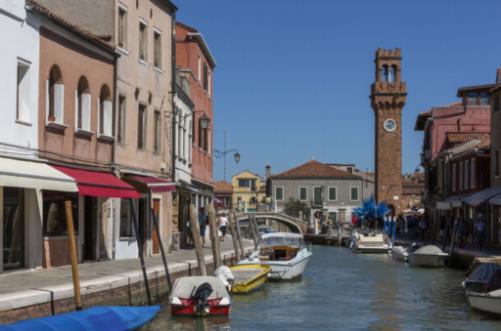Italy's rich history of artistry and craftsmanship is evident in the traditional lace and glass traditions of Burano and Murano. The intricate skill and expertise displayed in both industries have long been admired by visitors from around the world. In this article, we will delve into the unique characteristics and legacies of Burano's lace-making and Murano's glassblowing, highlighting the economic impact of these traditions on these two picturesque islands in the Venetian lagoon.

Murano's Legacy: The Art of Glassblowing
Murano, an island near Venice, Italy, is renowned for its centuries-old tradition of glassblowing. This art form has been passed down through generations, with master craftsmen creating intricate and beautiful glass pieces that are sought after by collectors around the world. The legacy of Murano's glassblowing tradition can be seen in the stunning chandeliers, vases, and sculptures that are produced on the island. The craftsmanship and skill required to create these pieces are truly remarkable, making Murano a must-visit destination for anyone interested in the art of glassblowing.
A Comparison of Traditional Lace Designs in Burano and Murano
Burano and Murano are two neighboring islands in the Venetian lagoon, known for their rich artisanal traditions of lace and glass making. While Murano is renowned for its exquisite glassblowing techniques, Burano is famous for its delicate lace designs. Despite their distinct specialties, both islands share a deep-seated commitment to preserving and celebrating their respective crafts.
In Burano, lace making has been a cherished tradition for centuries, with intricate patterns and designs passed down through generations. The art of lacemaking in Burano is characterized by meticulous attention to detail and precision, resulting in breathtakingly beautiful finished products. The delicate nature of Burano lace is a reflection of the island's tranquil and picturesque surroundings, lending a sense of elegance and sophistication to the craft.
On the other hand, Murano is synonymous with the art of glassblowing, a practice that has been honed and perfected over centuries. The glassmakers of Murano are known for their unparalleled skill and artistry, creating stunning works of art that are coveted around the world. Each piece of Murano glass is a testament to the island's rich cultural heritage and innovative spirit, showcasing a unique blend of tradition and modernity.
Although Burano and Murano have distinct artisanal traditions, both islands share a common commitment to preserving their cultural legacy. The intricate lace designs of Burano and the exquisite glass creations of Murano serve as testaments to the islands' rich artistic heritage and enduring craftsmanship. Visitors to Burano and Murano are treated to a glimpse of the past, where tradition and innovation merge to create timeless works of art that continue to captivate and inspire.
Exploring the Techniques Behind Murano Glass Artistry
The techniques behind Murano glass artistry date back centuries and require immense skill and precision to create such delicate pieces.
One of the key techniques used in Murano glass artistry is glassblowing. This ancient technique involves heating glass until it reaches a molten state, and then shaping it using various tools such as blowpipes and molds. Glassblowing allows artisans to create a wide range of shapes and designs, from delicate figurines to intricate chandeliers.
Another important technique in Murano glass artistry is glass cutting. This process involves carefully cutting and etching the glass to create patterns and designs. This technique requires a steady hand and a keen eye for detail, as even the slightest mistake can ruin the entire piece.
Millefiori, or "thousand flowers," is another technique commonly used in Murano glass artistry. This technique involves creating intricate patterns and designs by layering different colors of glass together and then pulling and twisting them to create unique patterns. The end result is a colorful and vibrant piece of glass art that is truly one-of-a-kind.
Overall, the techniques behind Murano glass artistry require a high level of skill, patience, and attention to detail. Artisans spend years honing their craft to create these beautiful works of art, making Murano glass a beloved tradition that continues to thrive in the modern world.
The Economic Impact of Lace and Glass Traditions on Burano and Murano
The economic impact of lace and glass traditions on Burano and Murano is significant, as both industries play a crucial role in the local economies of these two Venetian islands.
In Burano, the tradition of lace-making has been a source of income for generations of women on the island. The intricate and delicate lace designs produced in Burano are highly sought after by tourists and collectors around the world, bringing in a steady stream of revenue for the island. Many families in Burano rely on the income generated from lace-making to support themselves, making it a vital part of the local economy.
On the other hand, Murano is world-renowned for its glassblowing tradition. The artistry and craftsmanship of Murano glass have been passed down through generations, with skilled artisans creating stunning glass pieces that are exported internationally. The glass industry in Murano provides employment opportunities for many residents of the island, boosting the local economy and attracting tourists who come to witness the glassblowing process firsthand.
Overall, the lace and glass traditions in Burano and Murano contribute significantly to the economic vitality of these two Venetian islands. The industries not only provide income for local residents but also attract visitors from around the world, who are eager to experience the rich cultural heritage and expert craftsmanship that has been preserved for centuries.
